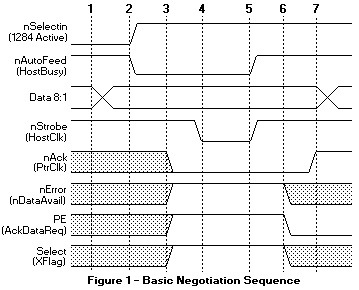|
|
| Bit | Description | Valid Bit Values (8765 4321) |
|---|---|---|
| 8 | Request Extensibility Link | 1000 0000 |
| 7 | Request EPP Mode | 0100 0000 |
| 6 | Request ECP Mode with RLE | 0011 0000 |
| 5 | Request ECP Mode without RLE | 0001 0000 |
| 4 | Reserved | 0000 1000 |
| 3 | Request Device ID | Return data using mode: 0000 0100 - Nibble Mode 0000 0101 - Byte Mode 0001 0100 - ECP Mode without RLE 0011 0100 - ECP Mode with RLE |
| 2 | Reserved | 0000 0010 |
| 1 | Byte Mode | 0000 0001 |
| none | Nibble Mode | 0000 0000 |

Please see the LEGAL - Trademark notice.
Feel free - send a  for any BUG on this page found - Thank you.
for any BUG on this page found - Thank you.